#Infrared Captured images
Explore tagged Tumblr posts
Video
DSC02237 (1)c1 (1)rsz by Jim Via Flickr: This photograph was taken with a Sony HDR-SR12E camera with flash and pointing up to the night sky in Greta NSW Australia... it was during a night sky watch session with dimensional entities and this was after a request to "show themselves" so believe it or not that is a fact... I suggest any that think otherwise, then prove this wrong... Genuine photograph with archived original and all evidence of dimensional entities here able to visit our planet... or is it? They most probably have been here a lot longer than humans... INFRARED DIMENSIONAL ENTITIES Dimensional Entities in Australia's night sky captured by way of IR cameras and Night vision Monocular scopes. Discovered technique by FRJS in 2009.
#Orbs#Australia#Research#anomalies#craft#Dimensional Entities#Disclosure#entities#infrared#IR#My Sky#nature#Night sky#phenomena#Science#sky#sky anomalies#Sony HDR-SR12E#Truth#ufo#UFOs#unknown#Entities of the Infrared world#existence of infrared DE's#Infrared Camera#infrared cameras#infrared capture#Infrared captured#Infrared Captured images#Infrared Captures 3 km in night sky Australi
0 notes
Text

"UV camera" is probably an inaccurate name. The camera is just expanding the spectrum it can capture to include UV.

The camera is still capturing the rainbow but it also captures a little bit into the purple. The more light reflected, the brighter the overall image. But if light is absorbed, it won't contribute to the brightness of the photo.
And since the sunscreen is absorbing a lot of UV light, their faces expose much darker.
You aren't actually seeing any UV light. Just the absence or presence of it making things lighter and darker. To see only UV light you'd need some kind of false color representation like predator vision.
A whlie back I was restoring a photo for a client and noticed a few people in the photo looked like they were donning black face makeup.

This didn't make a lot of sense because it was a team photo of an Australian rugby team from the 1930s and not a racist minstrel show.
And when I did my corrections, it turned out he was just a regular Aussie white dude.

I was initially very confused as to what was going on. But then I remembered modern camera sensors have a special filter to block any UV light that would affect the image. Cameras and lenses in the 30s did not have that technology and some film could expose beyond our visual spectrum—picking up a little bit of UV and infrared light.
Melanin absorbs UV light. Some white people have more than others. And so the young man in the photo appeared much darker than his teammates. In real life he was probably of similar complexion or a bit more tan. Maybe even sunburned.
It's also possible he was using rudimentary sunscreen. It was invented in the late 20s and I'm guessing athletes who were in the sun all day would be some of the first to be interested in sunscreen.
Another interesting effect caused by expanded spectrum cameras or black light photography—super freckles!

They are just dense spots of concentrated melanin.
Light is neat.
1K notes
·
View notes
Text
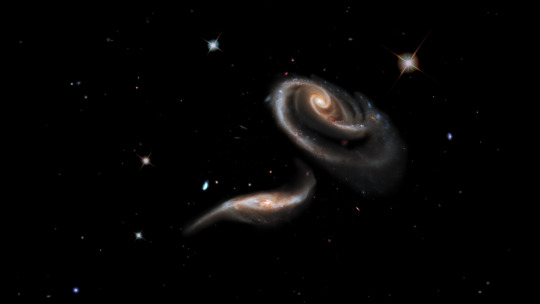
Love Letters from Space
Love is in the air, and it’s out in space too! The universe is full of amazing chemistry, cosmic couples held together by gravitational attraction, and stars pulsing like beating hearts.
Celestial objects send out messages we can detect if we know how to listen for them. Our upcoming Nancy Grace Roman Space Telescope will help us scour the skies for all kinds of star-crossed signals.
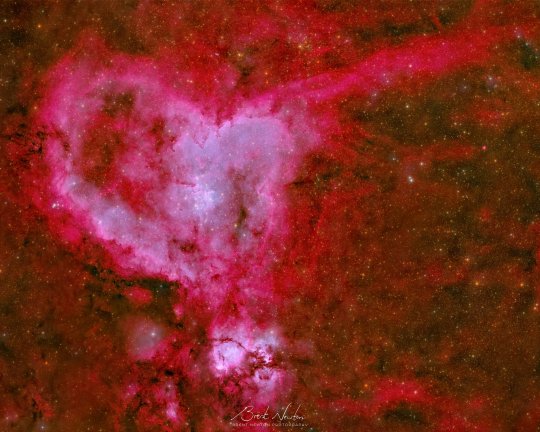
Celestial Conversation Hearts
Communication is key for any relationship – including our relationship with space. Different telescopes are tuned to pick up different messages from across the universe, and combining them helps us learn even more. Roman is designed to see some visible light – the type of light our eyes can see, featured in the photo above from a ground-based telescope – in addition to longer wavelengths, called infrared. That will help us peer through clouds of dust and across immense stretches of space.
Other telescopes can see different types of light, and some detectors can even help us study cosmic rays, ghostly neutrinos, and ripples in space called gravitational waves.
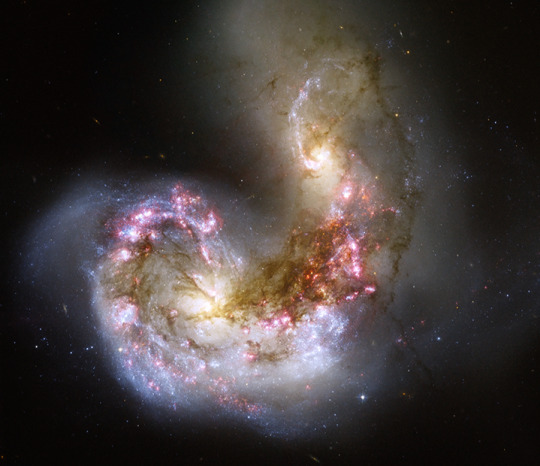
Intergalactic Hugs
This visible and near-infrared image from the Hubble Space Telescope captures two hearts locked in a cosmic embrace. Known as the Antennae Galaxies, this pair’s love burns bright. The two spiral galaxies are merging together, igniting the birth of brand new baby stars.
Stellar nurseries are often very dusty places, which can make it hard to tell what’s going on. But since Roman can peer through dust, it will help us see stars in their infancy. And Roman’s large view of space coupled with its sharp, deep imaging will help us study how galaxy mergers have evolved since the early universe.
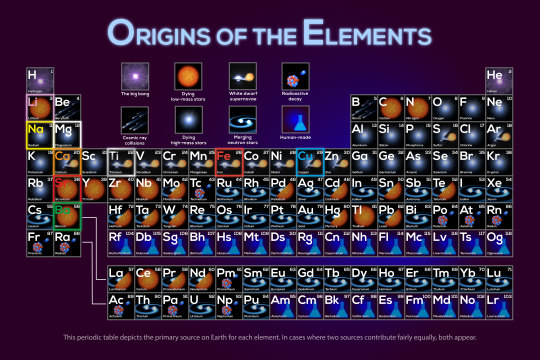
Cosmic Chemistry
Those stars are destined to create new chemistry, forging elements and scattering them into space as they live, die, and merge together. Roman will help us understand the cosmic era when stars first began forming. The mission will help scientists learn more about how elements were created and distributed throughout galaxies.
Did you know that U and I (uranium and iodine) were both made from merging neutron stars? Speaking of which…
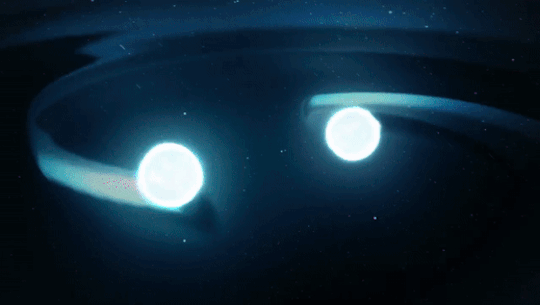
Fatal Attraction
When two neutron stars come together in a marriage of sorts, it creates some spectacular fireworks! While they start out as stellar sweethearts, these and some other types of cosmic couples are fated for devastating breakups.
When a white dwarf – the leftover core from a Sun-like star that ran out of fuel – steals material from its companion, it can throw everything off balance and lead to a cataclysmic explosion. Studying these outbursts, called type Ia supernovae, led to the discovery that the expansion of the universe is speeding up. Roman will scan the skies for these exploding stars to help us figure out what’s causing the expansion to accelerate – a mystery known as dark energy.
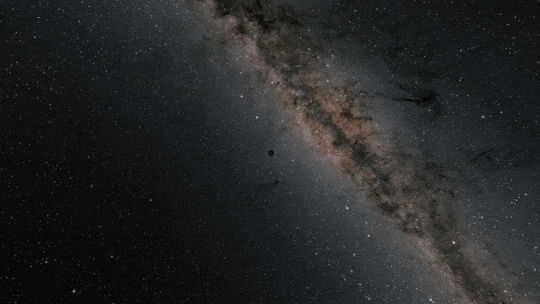
Going Solo
Plenty of things in our galaxy are single, including hundreds of millions of stellar-mass black holes and trillions of “rogue” planets. These objects are effectively invisible – dark objects lost in the inky void of space – but Roman will see them thanks to wrinkles in space-time.
Anything with mass warps the fabric of space-time. So when an intervening object nearly aligns with a background star from our vantage point, light from the star curves as it travels through the warped space-time around the nearer object. The object acts like a natural lens, focusing and amplifying the background star’s light.
Thanks to this observational effect, which makes stars appear to temporarily pulse brighter, Roman will reveal all kinds of things we’d never be able to see otherwise.
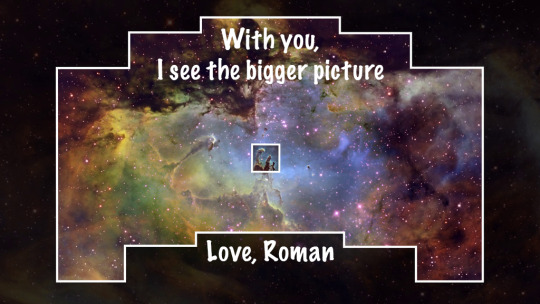
Roman is nearly ready to set its sights on so many celestial spectacles. Follow along with the mission’s build progress in this interactive virtual tour of the observatory, and check out these space-themed Valentine’s Day cards.
Make sure to follow us on Tumblr for your regular dose of space!
#NASA#astronomy#telescope#Roman Space Telescope#Valentine’s Day#space#science#STEM#nebula#chemistry#galaxies#black holes#rogue planets#exoplanets#Hubble Space Telescope#tech
3K notes
·
View notes
Text


Glittering image of a stellar nursery captured by @NASAHubble. The immense region of gas and dust is the birthing place of stars, which glow against the clouds. Bright clusters of newborn stars shine in infrared light shown here in pink. Clouds of gas and dust, resembling puffy cumulus clouds, are dotted with dark knots of denser dust.
Hubble’s infrared view allows us to pierce through the clouds and see stars that otherwise might be obscured. Unlike visible light, infrared wavelengths can travel through clouds of gas and dust, allowing us to see details of the young stars.
nasa
#space#outer space#galaxy#astronomy#hubble space telescope#stars#look up#the truth is out there#curators on tumblr
538 notes
·
View notes
Text
"The first satellite in a constellation designed specifically to locate wildfires early and precisely anywhere on the planet has now reached Earth's orbit, and it could forever change how we tackle unplanned infernos.
The FireSat constellation, which will consist of more than 50 satellites when it goes live, is the first of its kind that's purpose-built to detect and track fires. It's an initiative launched by nonprofit Earth Fire Alliance, which includes Google and Silicon Valley-based space services startup Muon Space as partners, among others.
According to Google, current satellite systems rely on low-resolution imagery and cover a particular area only once every 12 hours to spot significantly large wildfires spanning a couple of acres. FireSat, on the other hand, will be able to detect wildfires as small as 270 sq ft (25 sq m) – the size of a classroom – and deliver high-resolution visual updates every 20 minutes.
The FireSat project has only been in the works for less than a year and a half. The satellites are fitted with custom six-band multispectral infrared cameras, designed to capture imagery suitable for machine learning algorithms to accurately identify wildfires – differentiating them from misleading objects like smokestacks.
These algorithms look at an image from a particular location, and compare it with the last 1,000 times it was captured by the satellite's camera to determine if what it's seeing is indeed a wildfire. AI technology in the FireSat system also helps predict how a fire might spread; that can help firefighters make better decisions about how to control the flames safely and effectively.
This could go a long way towards preventing the immense destruction of forest habitats and urban areas, and the displacement of residents caused by wildfires each year. For reference, the deadly wildfires that raged across Los Angeles in January were estimated to have cuased more than $250 billion in damages.
Muon is currently developing three more satellites, which are set to launch next year. The entire constellation should be in orbit by 2030.
The FireSat effort isn't the only project to watch for wildfires from orbit. OroraTech launched its first wildfire-detection satellite – FOREST-1 – in 2022, followed by one more in 2023 and another earlier this year. The company tells us that another eight are due to go up toward the end of March."
-via March 18, 2025
#wildfire#wildfires#la wildfires#los angeles#ai#artificial intelligence#machine learning#satellite#natural disasters#good news#hope
722 notes
·
View notes
Text
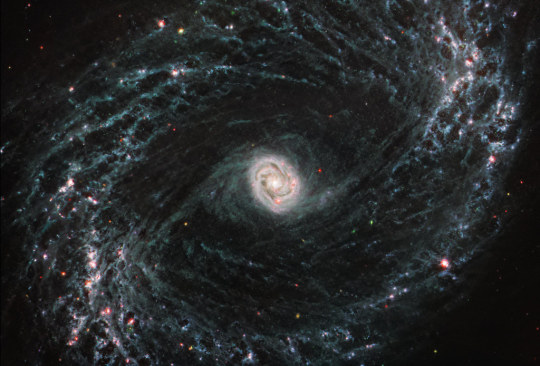
NGC 1433 captured by the James Webb Space Telescope by European Space Agency
This image taken by the NASA/ESA/CSA James Webb Space Telescope shows one of a total of 19 galaxies targeted for study by the Physics at High Angular resolution in Nearby Galaxies (PHANGS) collaboration. Nearby barred spiral galaxy NGC 1433 takes on a completely new look when observed by Webb’s Mid-Infrared Instrument (MIRI).
180 notes
·
View notes
Photo

2025 May 8
M1: The Incredible Expanding Crab Image Credit: NASA, ESA, CSA, STScI; Jeff Hester (ASU), Allison Loll (ASU), Tea Temim (Princeton University)
Explanation: Cataloged as M1, the Crab Nebula is the first on Charles Messier's famous list of things which are not comets. In fact, the Crab Nebula is now known to be a supernova remnant, an expanding cloud of debris from the death explosion of a massive star. The violent birth of the Crab was witnessed by astronomers in the year 1054. Roughly 10 light-years across, the nebula is still expanding at a rate of about 1,500 kilometers per second. You can see the expansion by comparing these sharp images from the Hubble Space Telescope and James Webb Space Telescope. The Crab's dynamic, fragmented filaments were captured in visible light by Hubble in 2005 and Webb in infrared light in 2023. This cosmic crustacean lies about 6,500 light-years away in the constellation Taurus.
∞ Source: apod.nasa.gov/apod/ap250508.html
104 notes
·
View notes
Text

Aurora lights, Webb camera, Neptune action! For the first time, astronomers have used the James Webb Space Telescope to capture bright auroral activity on Neptune. For many years, Neptune’s bright lights were the missing piece of the puzzle when it came to detecting auroras on the giant planets of our solar system.
Turns out, imaging the auroral activity on Neptune was only possible with Webb’s near-infrared sensitivity: https://webbtelescope.pub/424vcTI
#space#astronomy#stsci#science#nasa#universe#nasawebb#james webb space telescope#esa#csa jwst#neptune#solar system#planet#auroras#webb telescope
76 notes
·
View notes
Text
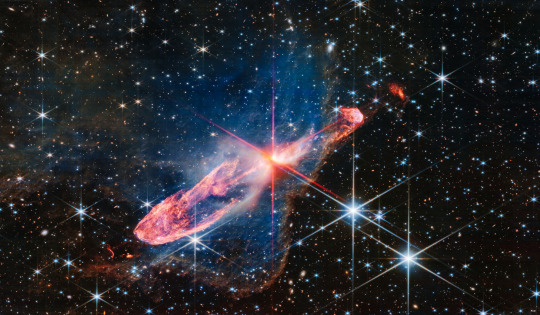
NASA’s James Webb Space Telescope has captured a tightly bound pair of actively forming stars, known as Herbig-Haro 46/47, in high-resolution near-infrared light. Look for them at the center of the red diffraction spikes, appearing as an orange-white splotch. Herbig-Haro 46/47 is an important object to study because it is relatively young – only a few thousand years old. Star systems take millions of years to fully form. Targets like this give researchers insight into how much mass stars gather over time, potentially allowing them to model how our own Sun, which is a low-mass star, formed – along with its planetary system.
Credits: Image: NASA, ESA, CSA. Image Processing: Joseph DePasquale (STScI)
1K notes
·
View notes
Text

An image captured by the James Webb Space Telescope shows Herbig-Haro 49/50, or simply HH 49/50, a type of nebula associated with star formation. The Near-Infrared Camera (NIRCam) and Mid-Infrared Instrument (MIRI) instruments were used in combination to observe infrared details of the outflows whose shape led to the object being nicknamed the Cosmic Tornado. For years, astronomers have wondered what the object they could barely see in images obtained with other instruments at the "tip of the tornado" was, and Webb helped them realize that it's a spiral galaxy that is far more distant.
71 notes
·
View notes
Video
20100220205619 (8)crsztagnotes by Jim Via Flickr: A newly edited Infrared capture as I continue through my thousands of archived videos as time permits. More than 50,000 units captured with infrared technique I developed over 13 years ago, unacknowledged by mainstream brain dead people who do not want humanity to progress... IMO. A slightly enhanced crop here is posted for you to view. The original is also in these files. All my videos are archived in original m2ts video files. - Available to research organisations by request. - Free of charge.
#Infrared Captured images#Unseen with human vision captures#New Science#Infrared Dimension#Never before seen Infrared Images#These are travelling the skies here on planet Earth#The science that mainstream do not want you to know about#Some of our neighbours here on this planet#Dimensional Entities#Infrared spectrum#Unseen Infared capture#Infared laser#Infrared Illumination#UAP dimensional craft#Outside of the box#What they don't want you to know#What they don't want you to see#Since time began#The watchers#flickr
0 notes
Text
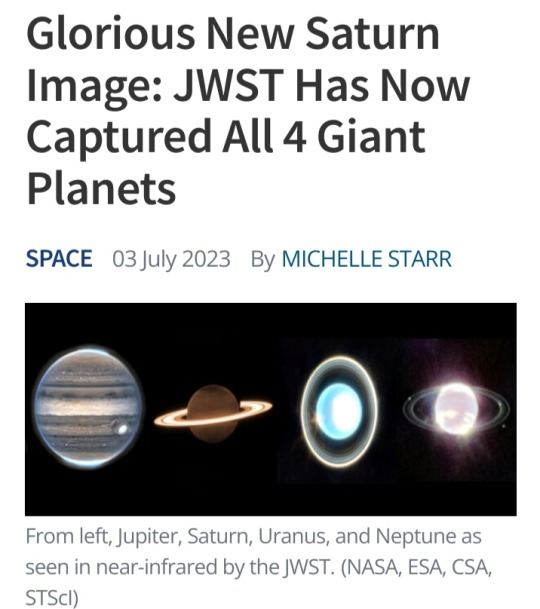
With the addition of Saturn, the James Webb Space Telescope has finally captured all four of our Solar System's giant worlds.
JWST's observations of the ringed planet, taken on 25 June 2023, have been cleaned up and processed, giving us a spectacular view of Saturn's glorious rings, shining golden in the darkness.
By contrast, the disk of Saturn is quite dark in the new image, lacking its characteristic bands of cloud, appearing a relatively featureless dim brown.
This is because of the wavelengths in which JWST sees the Universe – near- and mid-infrared.
These wavelengths of light are usually invisible to the naked human eye, but they can reveal a lot.
For example, thermal emission – associated with heat – is dominated by infrared wavelengths.
When you're trying to learn about what's going on inside a planet wrapped in thick, opaque clouds, studying its temperature is a valuable way to go about it.
Some elements and chemical processes emit infrared light, too. Seeing the planets of the Solar System in wavelengths outside the narrow range admitted by our vision can tell us a lot more about what they have going on.
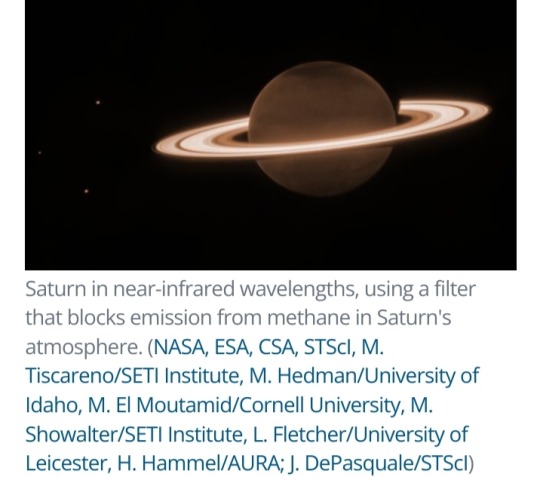
Saturn
As we saw last week, when we clapped eyes on the raw JWST Saturn images, the observations involved filters that dimmed the light of the planet, while allowing light from the rings and moons to shine brightly.
This is so a team led by planetary scientist Leigh Fletcher of the University of Leicester in the UK can study the rings and moons of Saturn in more detail.
They hope to identify new ring structures and, potentially, even new moons orbiting the gas giant.
The image above shows three of Saturn's moons, Dione, Enceladus and Tethys, to the left of the planet.
Although dim, the disk of the planet also reveals information about Saturn's seasonal changes.
The northern hemisphere is reaching the end of its 7-year summer, but the polar region is dark. An unknown aerosol process could be responsible.
Meanwhile, the atmosphere around the edges of the disk appears bright, which could be the result of methane fluorescence, or the glow of trihydrogen, or both. Further analysis could tell us which.
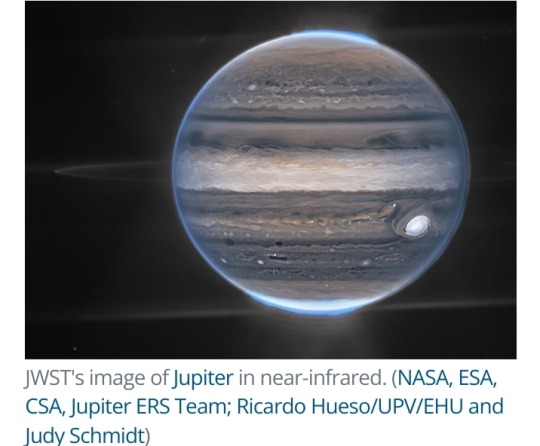
Jupiter
Jupiter was the first of the giant planets to get the JWST treatment, with images dropping in August of last year – and boy howdy were they stunning.
The spectacular detail seen in the planet's turbulent clouds and storms was perhaps not entirely surprising.
However, we also got treated to some rarely seen features: the permanent aurorae that shimmer at Jupiter's poles, invisible in optical wavelengths, and Jupiter's tenuous rings.
We also saw two of the planet's smaller, lesser-known moons, Amalthea and Adrastea, with fuzzy blobs of distant galaxies in the background.
"This one image sums up the science of our Jupiter system program, which studies the dynamics and chemistry of Jupiter itself, its rings, and its satellite system," said astronomer Thierry Fouchet of Paris Observatory in France, who co-led the observations.
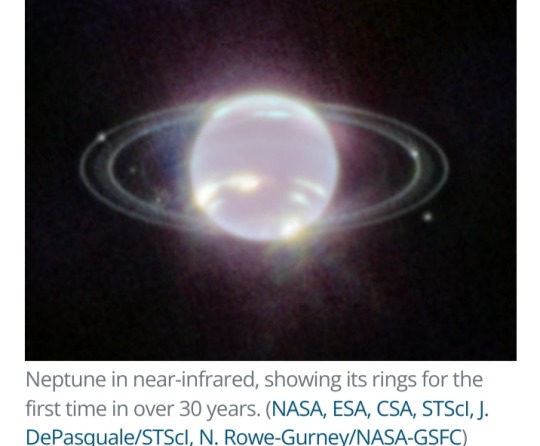
Neptune
Observations of Neptune arrived in the latter half of September 2022.
Because Neptune is so very far away, it tends to get a little neglected; you're probably used to seeing, if anything, the images taken by Voyager 2 when it flew past in 1989.
JWST's observations gave us, for the first time in more than 30 years, a new look at the ice giant's dainty rings – and the first ever in infrared.
It also revealed seven of Neptune's 14 known moons, and bright spots in its atmosphere.
Most of those are storm activity, but if you look closely, you'll see a bright band circling the planet's equator.
This had never been seen before and could be, scientists say, a signature of Neptune's global atmospheric circulation.
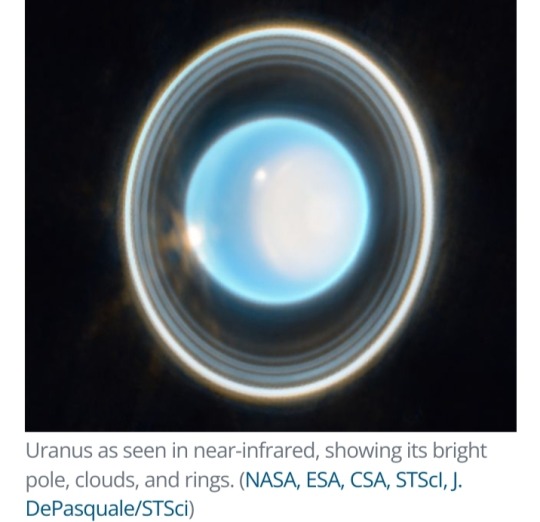
Uranus
Uranus is also pretty far away, but it's also a huge weirdo. Although very similar to Neptune, the two planets are slightly different hues, which is something of a mystery.
Uranus is also tipped sideways, which is challenging to explain too.
JWST's observations, released in April 2023, aren't solving these conundrums.
However, they have revealed 11 of the 13 structures of the incredible Uranian ring system and an unexplained atmospheric brightening over the planet's polar cap.
JWST has a lot to say about the early Universe; but it's opening up space science close to home, too.
As its first year of operations comes to an end, we can't help but speculate what new wonders will be to come in the years ahead.
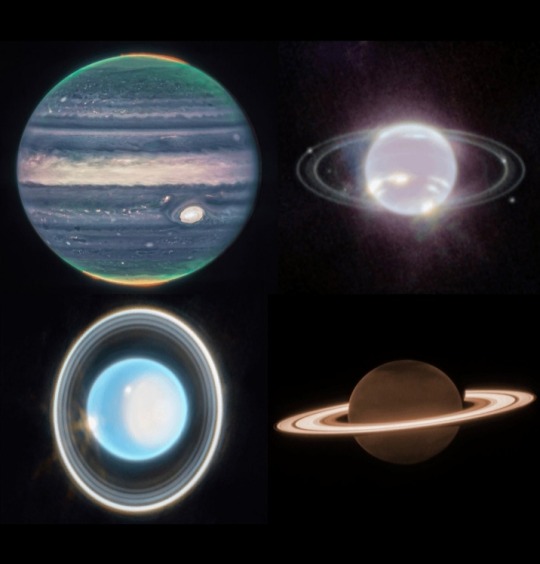
Top: Jupiter - Neptune / Bottom: Uranus - Saturn
Credit: NASA
#James Webb Space Telescope#Solar System#Saturn#Jupiter#Uranus#Neptune#planets#space#universe#infrared wavelengths#wavelengths#JWST#Leigh Fletcher#planetary science#Thierry Fouchet#moons#Voyager 2#giant planets#astronomy
1K notes
·
View notes
Text
IS THE LARGEST STORM OF OUR SOLAR SYSTEM IS MOVING??
Blog#445
Wednesday, October 16th, 2024.
Welcome back,
New observations of Jupiter’s Great Red Spot captured by the Hubble Space Telescope show that the 190-year-old storm wiggles like gelatin and shape-shifts like a squeezed stress ball.
The unexpected observations, which Hubble took over 90 days from December to March, show that the Great Red Spot isn’t as stable as it appears, according to astronomers.

The Great Red Spot, or GRS, is an anticyclone, or a large circulation of winds in Jupiter’s atmosphere that rotates around a central area of high pressure along the planet’s southern midlatitude cloud belt. And the long-lived storm is so large — the biggest in the solar system — that Earth could fit inside it.
Although storms are generally considered unstable, the Great Red Spot has persisted for nearly two centuries. But the observed changes in the storm appear related to its motion and size.

A time lapse of the images shows the vortex “jiggling” like gelatin and expanding and contracting over time.
Researchers described the observation in an analysis published in The Planetary Science Journal and presented Wednesday at the 56th annual meeting of the American Astronomical Society’s Division for Planetary Sciences in Boise, Idaho.

“While we knew its motion varies slightly in its longitude, we didn’t expect to see the size oscillate as well. As far as we know, it’s not been identified before,” said lead study author Amy Simon, a planetary scientist at NASA’s Goddard Space Flight Center in Greenbelt, Maryland, in a statement.
“This is really the first time we’ve had the proper imaging cadence of the GRS,” Simon said. “With Hubble’s high resolution we can say that the GRS is definitively squeezing in and out at the same time as it moves faster and slower. That was very unexpected.”

Astronomers have observed the iconic crimson feature for at least 150 years, and sometimes, the observations result in surprises, including the latest revelation that the storm’s oval shape can change dimensions and look skinnier or fatter at times.
Recently, a separate team of astronomers peered into the heart of the Great Red Spot using the James Webb Space Telescope to capture new details in infrared light. The Hubble observations were made in visible and ultraviolet light.

The study, published September 27 in the Journal of Geophysical Research: Planets, revealed that the Great Red Spot is cold in the center, which causes ammonia and water to condense inside the vortex and create thick clouds. The research team also detected the gas phosphine within the storm, which could play “a role in generating those mysterious” red colors that make the Great Red Spot so iconic, said study coauthor Leigh Fletcher, a professor of planetary science at the UK’s University of Leicester, in a statement.
Originally published on https://amp-cnn-com.cdn.ampproject.org
COMING UP!!
(Saturday, October 19th, 2024)
"WHY DOES OUR UNIVERSE EXIST??"
#astronomy#outer space#alternate universe#astrophysics#universe#spacecraft#white universe#space#parallel universe#astrophotography
54 notes
·
View notes
Text
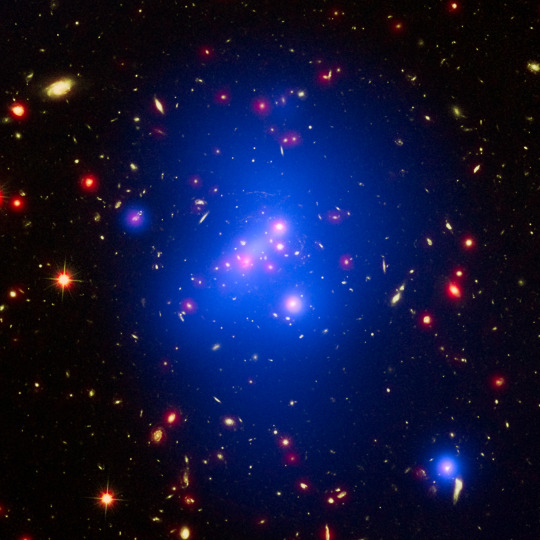
Astronomers used three of NASA's Great Observatories to capture this multiwavelength image showing galaxy cluster IDCS J1426.5+3508. It includes X-rays recorded by the Chandra X-ray Observatory in blue, visible light observed by the Hubble Space Telescope in green, and infrared light from the Spitzer Space Telescope in red. This rare galaxy cluster has important implications for understanding how these megastructures formed and evolved early in the universe.
How Astronomers Time Travel
Let’s add another item to your travel bucket list: the early universe! You don’t need the type of time machine you see in sci-fi movies, and you don’t have to worry about getting trapped in the past. You don’t even need to leave the comfort of your home! All you need is a powerful space-based telescope.
But let’s start small and work our way up to the farthest reaches of space. We’ll explain how it all works along the way.
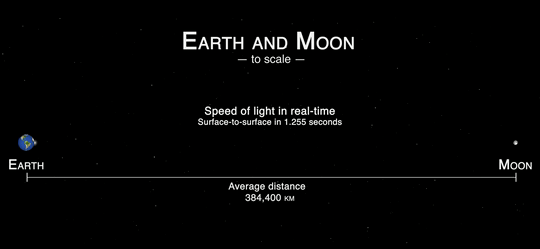
This animation illustrates how fast light travels between Earth and the Moon. The farther light has to travel, the more noticeable its speed limit becomes.
The speed of light is superfast, but it isn’t infinite. It travels at about 186,000 miles (300 million meters) per second. That means that it takes time for the light from any object to reach our eyes. The farther it is, the more time it takes.
You can see nearby things basically in real time because the light travel time isn’t long enough to make a difference. Even if an object is 100 miles (161 kilometers) away, it takes just 0.0005 seconds for light to travel that far. But on astronomical scales, the effects become noticeable.
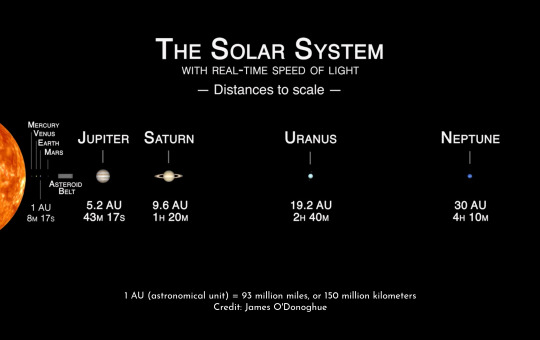
This infographic shows how long it takes light to travel to different planets in our solar system.
Within our solar system, light’s speed limit means it can take a while to communicate back and forth between spacecraft and ground stations on Earth. We see the Moon, Sun, and planets as they were slightly in the past, but it's not usually far enough back to be scientifically interesting.
As we peer farther out into our galaxy, we use light-years to talk about distances. Smaller units like miles or kilometers would be too overwhelming and we’d lose a sense of their meaning. One light-year – the distance light travels in a year – is nearly 6 trillion miles (9.5 trillion kilometers). And that’s just a tiny baby step into the cosmos.
youtube
The Sun’s closest neighboring star, Proxima Centauri, is 4.2 light-years away. That means we see it as it was about four years ago. Betelgeuse, a more distant (and more volatile) stellar neighbor, is around 700 light-years away. Because of light’s lag time, astronomers don’t know for sure whether this supergiant star is still there! It may have already blasted itself apart in a supernova explosion – but it probably has another 10,000 years or more to go.
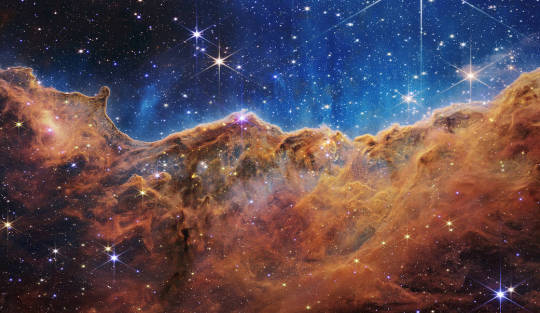
What looks much like craggy mountains on a moonlit evening is actually the edge of a nearby, young, star-forming region NGC 3324 in the Carina Nebula. Captured in infrared light by the Near-Infrared Camera (NIRCam) on NASA’s James Webb Space Telescope, this image reveals previously obscured areas of star birth.
The Carina Nebula clocks in at 7,500 light-years away, which means the light we receive from it today began its journey about 3,000 years before the pyramids of Giza in Egypt were built! Many new stars there have undoubtedly been born by now, but their light may not reach Earth for thousands of years.
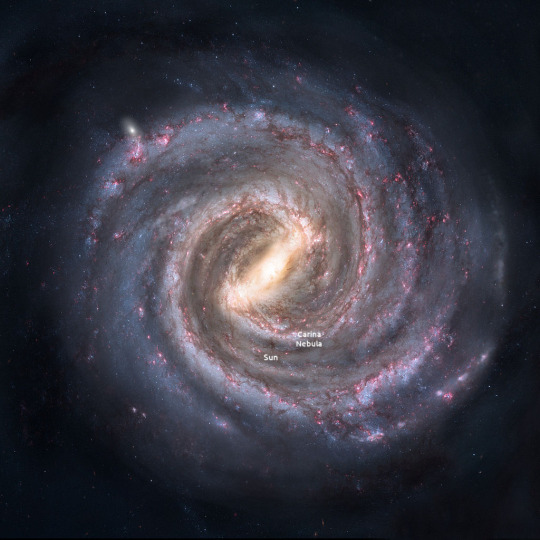
An artist’s concept of our Milky Way galaxy, with rough locations for the Sun and Carina nebula marked.
If we zoom way out, you can see that 7,500 light-years away is still pretty much within our neighborhood. Let’s look further back in time…
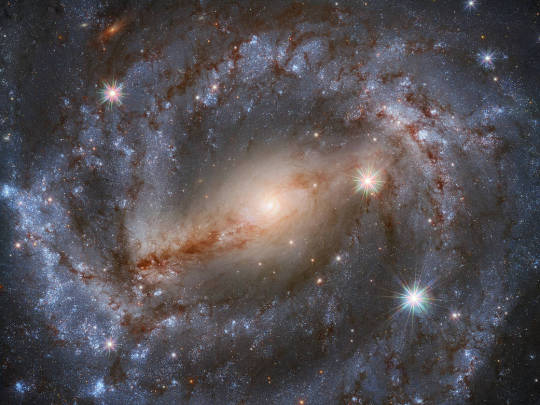
This stunning image by the NASA/ESA Hubble Space Telescope features the spiral galaxy NGC 5643. Looking this good isn’t easy; 30 different exposures, for a total of nine hours of observation time, together with Hubble’s high resolution and clarity, were needed to produce an image of such exquisite detail and beauty.
Peering outside our Milky Way galaxy transports us much further into the past. The Andromeda galaxy, our nearest large galactic neighbor, is about 2.5 million light-years away. And that’s still pretty close, as far as the universe goes. The image above shows the spiral galaxy NGC 5643, which is about 60 million light-years away! That means we see it as it was about 60 million years ago.
As telescopes look deeper into the universe, they capture snapshots in time from different cosmic eras. Astronomers can stitch those snapshots together to unravel things like galaxy evolution. The closest ones are more mature; we see them nearly as they truly are in the present day because their light doesn’t have to travel as far to reach us. We can’t rewind those galaxies (or our own), but we can get clues about how they likely developed. Looking at galaxies that are farther and farther away means seeing these star cities in ever earlier stages of development.
youtube
The farthest galaxies we can see are both old and young. They’re billions of years old now, and the light we receive from them is ancient since it took so long to traverse the cosmos. But since their light was emitted when the galaxies were young, it gives us a view of their infancy.

This animation is an artist’s concept of the big bang, with representations of the early universe and its expansion.
Comparing how fast objects at different distances are moving away opened up the biggest mystery in modern astronomy: cosmic acceleration. The universe was already expanding as a result of the big bang, but astronomers expected it to slow down over time. Instead, it’s speeding up!
The universe’s expansion makes it tricky to talk about the distances of the farthest objects. We often use lookback time, which is the amount of time it took for an object’s light to reach us. That’s simpler than using a literal distance, because an object that was 10 billion light-years away when it emitted the light we received from it would actually be more than 16 billion light-years away right now, due to the expansion of space. We can even see objects that are presently over 30 billion light-years from Earth, even though the universe is only about 14 billion years old.

This James Webb Space Telescope image shines with the light from galaxies that are more than 13.4 billion years old, dating back to less than 400 million years after the big bang.
Our James Webb Space Telescope has helped us time travel back more than 13.4 billion years, to when the universe was less than 400 million years old. When our Nancy Grace Roman Space Telescope launches in a few years, astronomers will pair its vast view of space with Webb’s zooming capabilities to study the early universe in better ways than ever before. And don’t worry – these telescopes will make plenty of pit stops along the way at other exciting cosmic destinations across space and time.
Learn more about the exciting science Roman will investigate on X and Facebook.
Make sure to follow us on Tumblr for your regular dose of space!
#NASA#astronomy#telescope#Roman Space Telescope#dark energy#galaxies#cosmology#astrophysics#stars#galaxy#Hubble#Webb#Chandra#Spitzer#space images#Youtube
3K notes
·
View notes
Text

Space Walz - February 11th, 1997.
"Astronaut Carl Walz waves at his colleagues from the aft end of the Space Shuttle Discovery's payload bay - during a 1993 spacewalk to evaluate tools, tethers, and a foot restraint slated for use in the first Hubble Space Telescope servicing mission. The successful launch of Discovery on February 11th, 1997, begun the second servicing mission to the Hubble. Discovery's crew would rendezvous with the orbiting telescope and capture it with the shuttle's manipulator arm. With Hubble in the payload bay, the crew would conduct spacewalks to replace two existing instruments with new ones. Newly installed were the Space Telescope Imaging Spectrograph and the Near Infrared Camera and Multi-Object Spectrometer. Other hardware would be replaced and upgraded, including the telescope's Fine Guidance Sensor. The improved instrumentation would extend the Hubble's ability to explore the distant Universe."
#nasa#space#cosmos#universe#astronomy#astrophysics#astrophotography#astronaut#hubble space telescope
32 notes
·
View notes
Text
Behold NGC 2283, a barred spiral galaxy 45 million light-years away captured by James Webb Telescope

The James Webb Space Telescope has done it again! Today, NASA/ESA/CSA released Webb’s latest mesmerizing image—a breathtaking view of the barred spiral galaxy NGC 2283, located 45 million light-years away in the constellation Canis Major. This cosmic marvel, captured using Webb’s Near-Infrared Camera (NIRCam) and Mid-Infrared Instrument (MIRI), showcases the galaxy’s intricate structure, star-forming regions, and the life cycle of stars in dazzling detail.
A Glimpse into the Heart of NGC 2283
Barred spiral galaxies like NGC 2283 have a central bar of stars, acting as a cosmic highway that channels gas into the galaxy’s core, fueling star formation. Webb’s infrared eyes reveal the delicate interplay between stars, gas, and dust, bringing into focus the glowing knots of gas where new stars are being born. These dense pockets of hydrogen, ignited by stellar nurseries, illuminate the graceful spiral arms winding around the core.
The Power of Infrared Imaging
Webb observed NGC 2283 for 17 minutes, collecting data across six different infrared filters. These filters allow astronomers to peer through cosmic dust and uncover hidden details. The image reveals:
Brilliant star clusters scattered throughout the spiral arms
Polycyclic aromatic hydrocarbons (PAHs), sooty molecules that help astronomers trace cosmic chemistry
Interstellar gas clouds heated by young, massive stars
Foreground stars from our Milky Way, their diffraction spikes adding to the celestial display
A Galaxy Shaped by Stellar Explosions
NGC 2283 is no stranger to cosmic fireworks. Just over two years ago, astronomers witnessed a stellar explosion in this very galaxy. The supernova, SN 2023AXU, was a Type II supernova—the violent death of a massive star at least eight times the mass of our Sun. These spectacular explosions enrich the galaxy with elements like oxygen and sodium, seeding the next generation of stars and continuing the grand cosmic cycle.
Part of a Larger Cosmic Survey
This image is part of an ambitious Webb program (#3707) aimed at studying the intricate relationships between stars, gas, and dust in 55 nearby star-forming galaxies. By observing these galactic ecosystems, astronomers hope to unravel the mysteries of star formation and galaxy evolution, giving us deeper insights into our own Milky Way’s origins.
A Cosmic Time Machine
As we marvel at this new glimpse of NGC 2283, we are reminded that every light-year Webb’s gaze traverses is a journey back in time. This image captures NGC 2283 as it was 45 million years ago—when early primates roamed Earth and our planet was undergoing climatic shifts. Through Webb’s lens, we witness history written in the language of starlight.
Stay tuned for more stunning discoveries as Webb continues to unlock the universe’s deepest secrets. What do you see in this cosmic portrait? Share your thoughts in the comments! Visit www.jameswebbdiscovery.com for the latest discoveries.
#nasa#james webb space telescope#jwst#webb discoveries#spaceexploration#jameswebbtelescope#astronomy#stargazing
28 notes
·
View notes

